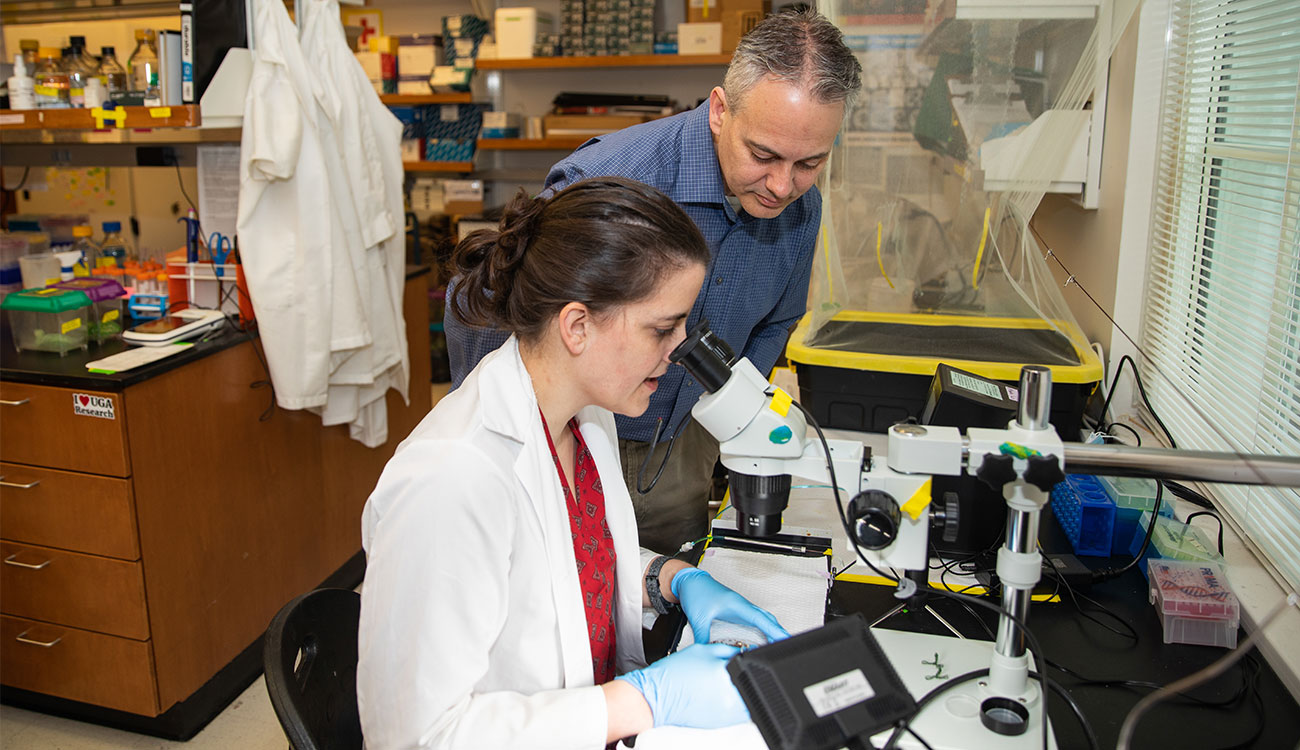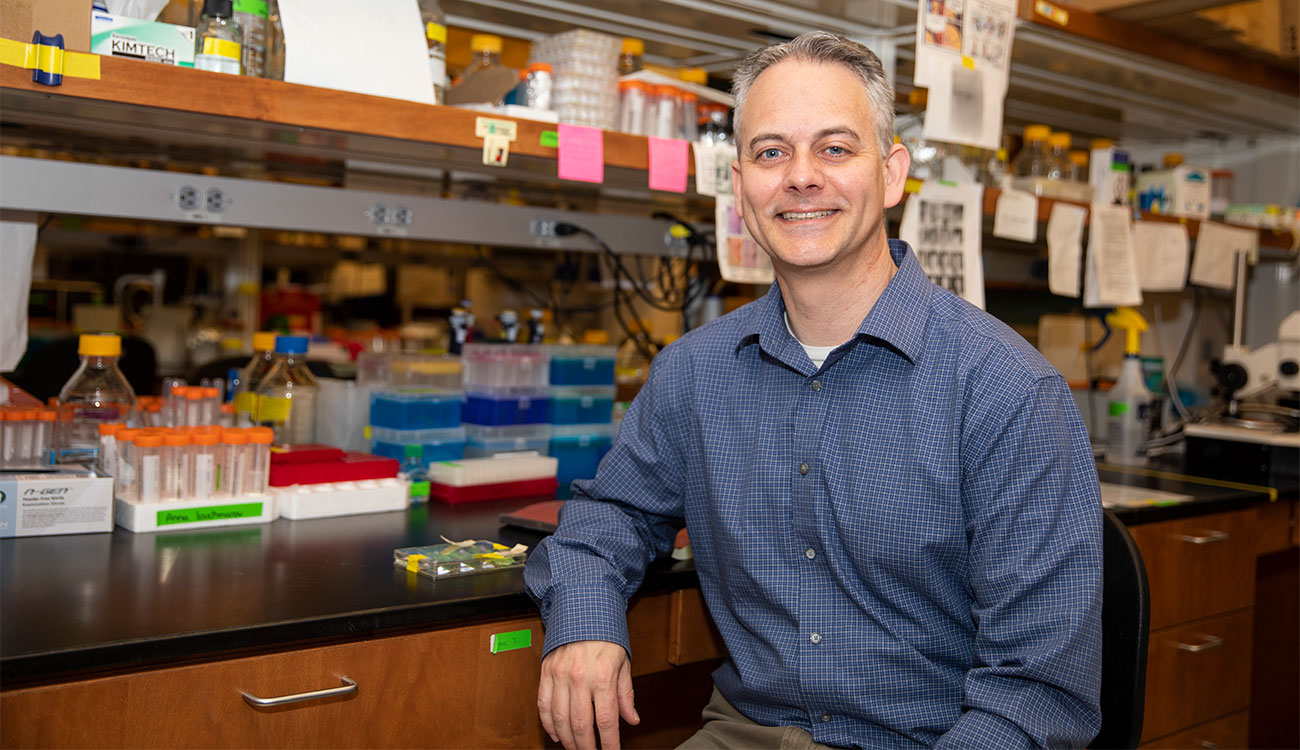Three years ago, Doug Menke led a team that became the first in the world to create a gene-edited lizard. A professor of genetics in the Franklin College of Arts & Sciences and director of UGA’s Developmental Biology Alliance, Menke was recognized last spring with a UGA Creative Research Medal for the accomplishment.
In this interview, Menke discusses his award-winning work, how he fell into the work of genetics and what lizard genetics can teach us about human biology.
What made you want to pursue a career in genetics?
I’ve been very interested in biology for as long as I can remember. My family lived in Miami and then later in Texas, where there were all sorts of animals to catch, including anolis lizards. So a long-running interest of mine has been animal biology.
When I entered graduate school in the mid-1990s, I knew I wanted to study gene function in animals. At the time, if you wanted to make targeted gene mutations in a vertebrate, the only animal you could really do that in was mice. I decided to work with mice so I could make mutations to understand the biology of how vertebrate genes work. And that’s the model I’ve been using for decades. But the advent of CRISPR technology in 2013 opened up the possibility of doing gene editing in all sorts of different species.
What led you to decide to work with lizards?
If you look at where major research discoveries have occurred, they’ve happened in a variety of different species—from microbes to monkeys, and everything in between. Each group of animals has its own unique biology. If you only look in a few organisms, you’re really limiting the amount of biology you can explore and discover. For example, reptiles and mammals have many shared traits, but mammals don’t have scales. If you want to identify genes involved in building scales, you have to work with reptiles or other scaled animals.
So the big motivation for working with lizards is simply that this is a group that includes thousands of species in which no one has studied gene function. If you don’t look at these less-studied organisms, you are limiting the amount of interesting and important biology you can discover. That’s the big picture.
Can you describe the moment you realized you’d succeeded with editing the brown anoles?
I was in the middle of a meeting when I received a text message from Ashley Rasys, a doctoral student in my lab, with a stunning picture of an albino anole that had just hatched. Needless to say, it was an exciting moment!
What applications does your work have for human biology?
One concrete example is the use of lizards to investigate eye development and, more specifically, an eye structure called the fovea, which is important for high acuity vision. The fovea is present in humans and anolis lizards but is absent from the eyes of major biomedical research organisms, including mice, frogs and zebrafish. You can’t study a structure that’s not present in your research model, right? In terms of direct applications to human research, I am working with my colleague Jim Lauderdale, a faculty member in UGA’s Department of Cellular Biology, to establish lizard strains that can be used to understand human foveal disorders.

How did it feel to win UGA’s Creative Research Medal this year?
Being awarded the Creative Research Medal is a reflection on the quality of researchers that are in my lab. All of this research happens because I’m working with an incredibly talented group of researchers—and lizard gene-editing, in particular, was developed by Ashley Rasys, a dual Ph.D./D.V.M. student. Ashley is an extremely creative researcher who combined her expertise in veterinary medicine with her interest in genetics to develop lizard gene-editing technology. It’s her unique combination of skills and her inquisitive nature that allowed her to develop this technology in my lab. She then introduced the technology to other students and researchers in the lab.
So, an award like this is not just personally important to me, but also a reflection of the team of researchers I work with and the high quality of research they perform. I’m proud of Ashley and the other students in the lab who have not just developed the technology but have gotten it to work well in an animal no one else has done gene-editing in before.
What are you currently working on?
Another project we have going on is related to the evolution of body form. We’re trying to understand how bodies of animals develop and how differences between the bodies of diverse species are encoded in the genome. In the case of these lizards, we know some anolis species have very short legs and some species have very long legs—what’s controlling these differences? A fundamental problem in biology is understanding trait differences between individuals, either of the same species or different species. And we’re trying to understand how traits between individuals and traits between different species are controlled genetically.
In terms of relevance to human biology and human disease, there are many different syndromes that are characterized by alterations in limb size, limb shape, digit number, etc. By exploring how limbs form and develop in lizards, we’re likely to also get information that’s relevant for limb development in humans.
Do you plan on applying this research method to other reptile species?
For the moment, we’re focused on one species, the brown anole. We didn’t pick this reptile randomly; we picked it because it’s very abundant and easy to obtain. The brown anole is native to Cuba and the surrounding Caribbean islands, but they were introduced to Florida many, many decades ago. And in fact, if you go to Florida and you see a little brown lizard scampering around on a light post or a fence, chances are it’s a brown anole. You can also find the brown anole in parts of south and coastal Georgia. One feature that makes it invasive is its high reproduction rate—it lays lots of eggs—which also makes it an easy reptile to work with in our research lab.
We have plans, though, to develop similar gene-editing approaches in other reptiles, including geckos. And we have a new collaboration with a gecko lab run by Dr. Anthony Gamble at Marquette University, so in the longer term we do hope to introduce these gene-editing technologies to other reptiles.
What’s next for you and your team?
Right now, we have the most basic form of gene-editing working, where we can select a gene that we want to mutate and break it, so it no longer works. But there are certain things we can’t do with the technology yet—for instance, the introduction of genes from other species. We don’t have the ability to add genes into the reptile genome.
We’d like to get that technology working. For example, if we identify an interesting change in a DNA sequence that differs between a long-limbed and a short-limbed lizard species, and we want to change the version of a gene that’s present in one species and replace it with another, we don’t yet have the ability to do that more sophisticated type of gene editing.
We’re plan to continue using our gene-editing method to explore reptile pigmentation, eye development and limb development. And in a newer project, we’re studying how sex determination works in these reptiles. This particular group of reptiles has an X chromosome and a Y chromosome, but those chromosomes are completely different from the X and Y chromosomes found in mammals, and we’d like to understand more about that biology.






